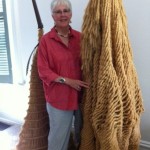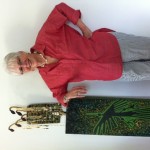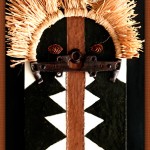“In my paintings, I am exploring uncharted territories and push at the boundaries I find,” said Anne Straus, 75, a multimedia artist who has lived in Wyoming, Ohio since 1963. “I see visions of forgotten times, and I paint them with the eye of my heart. I am an explorer, a messenger bringing back ethnic images.”
A frequent traveler with her retired husband Fred, Straus has visited West Africa several times. As a result, her art reflects tribal influences in color, design and texture. “The tribal world of Africa is rapidly disappearing as the siren call of our western culture is too attractive to ignore,” she said. But, “I seek to commemorate this world visually.” She related to the painted villages of Ghana and Burkina Faso and translated the dreams and symbols of West African women who still paint the walls of their village. “My heart opened up when I saw the art,” she said.
On her walls at home are encaustic painted shovels, which have become the mask or head on wooden spirit sculptures painted in acrylic. The patterns of the Kuba and Bwa tribes located in West Africa influenced her art by giving her permission to use symbols such as loose triangles, squares and stripes that were in her unconscious mind. “Tribal art is other oriented. It can give thanks for survival. It is larger than the individual,” she said.
In addition to Africa, Straus has visited the Great Serpent Mound, a three-foot-high prehistoric effigy mound located on a plateau of the Serpent Mound crater along Ohio Brush Creek in Adams County, Ohio. She uses the imagery of the Serpent Mound in her art work. Living nearby this earthwork, the myth of the snake and egg entered her imagination derived from the coils and head of the mound. With her lifetime of collecting old, usually rusty, metal tools, Straus formed shapes bringing an ancient myth into our time without sacrificing the sense of mystery at the effigy mound. As a result, she did several sculptures of a snake and egg.
Born in Scarsdale, New York, she graduated from Mt. Holyoke College in Massachusetts with a major in English literature and minor in art. During a time when feminism was not in vogue, Straus was trained to argue and question. “We lived it (feminism) without a name,” she said. Richard Glenn Gettell, president of Mt. Holyoke (1957-1968) when Straus attended, called the students “uncommon women.” To this day, she questions “What if” and “Why not?” Her inquisitiveness leads her down paths not always taken.
She welds rusty tools to build a sculpture; makes fiber sculpture by tying rope into knots, creates encaustic paintings using layers of colored wax and combines antique and new beads from all over the world to create jewelry. She balances opposites in her paintings and sculpture to achieve harmony.
However, Straus is always open to learning new skills. “You back into things without realizing it,” she said. “Every time I take myself out of my comfort level, I grow. It’s like travel: you open yourself up. I don’t want to do the same thing: the play goes out of it.”
In elementary school, she could not draw and stay within the lines. But she forged ahead in basic art, and found she loved playing with clay. From there came sculptures. Originally employed at Procter & Gamble, she left to have twins Michael and David in 1962. A third son Steve was born later.
She decided to join the Craft Guild of Greater Cincinnati where she found training. Some of her best friends who remain today. “Through the Craft Guild, I grew as an artist,” she said. Straus studied stone sculpture, welding and macramé. She also met friends with whom she still stays in contact. In addition, she took classes at the Art Academy of Cincinnati. To be considered a complete artist, she needed to learn how to paint. Her good friend Patrice Trauth, now retired Ursuline Academy art instructor, showed her the way. At the same time she discovered, “Some art forms like loom weaving are not for me.”
In the 1970’s, Straus joined the Contemporary Artifacts Co-op Gallery on Fourth Street, when it was the art center of Cincinnati. She remained a member for 17 years. “It was a very friendly way to get my work out,” she commented. Also in the 1970’s, Nancy Graves, (1939 – 1995) an American printmaker, anthropologist, scientist and sculptor who had a show at the Contemporary Art Center. That exhibit influenced Straus by Graves’ use of natural phenomena such as camels and maps of the moon. Particularly interested in camels, Graves used pieces of their hides to create haunting sculptural strips, which hung in groups from the ceiling of a gallery at CAC… moving as air blew around and through them… as if the animals were wandering through. Straus was inspired to use rusted objects, stones and tools to create her art.
Fast forward to the 21st century, Straus finds “contemporary art is more of an ego thing to me.” Cincinnati, she feels, is more a music city than an art city although she thinks the quality of local artists is excellent. With art galleries in Over-the-Rhine, O’Bryonville, downtown, Hyde Park, Oakley, East Walnut Hills and other locations, Straus doesn’t find one centralized art district.
She has had many shows throughout the Midwest, often outside Cincinnati. Straus would still like to have an exhibit of her current work here. Presently, she is working on small weavings (2 l/2” x 3 l/2”) on hardware cloth which will be displayed as part of a traveling show Tripletta curated by Paige Wideman in August 2014 at Main Street Yoga Gallery in Over-the-Rhine. “There aren’t many places to show my work,” she lamented.
As far as her goals, she said, “If you keep the stakes low, you can over perform.” Straus had no intention of becoming a nationally known artist. “I like my life here,” she said. “I don’t need to be as famous as Louise Nevelson,” Straus commented although Nevelson (1899-1988) was an American sculptor who influenced her work by taking found objects and transforming them into art. “My best time is to go into the studio,” located in a former carriage house behind her home.
“I am always in a new place: that’s what creating is about,” said Straus. “I want to keep working for ever.”
- Fiber Art – 1980’s
- Four Corners Spirit
- Peruvian Spirit – 2014
- Serpent and Mound Sculpture
- Black and White House
- Fetish Spirit









